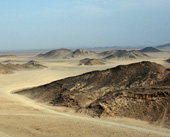Drag & Drop content in the header area - This message will disappear once the site is published
Women such as Nawal Al Saadawi[2], the founder of the Arab Women’s Solidarity Network, who broke social taboos by addressing the sexual oppression in every day customs, affiliated with values of western feminism. On the other hand, Zainab al-Ghazali, the founder of the Islamic Women’s Association promoted a feminism that was strongly Islamic and local in its roots.
|
Nabawiyya Musa (1890-1951)
|
Importantly the historian Margot Badran notes that:
‘Although she was active in Egypt for nearly half a century and was a prominent figure in education, she has been neglected in general accounts of modern Egypt, a fate shared with other women – even Amir Boktor in his history of education in Egypt, overlooked her.’ [6]
‘Although she was active in Egypt for nearly half a century and was a prominent figure in education, she has been neglected in general accounts of modern Egypt, a fate shared with other women – even Amir Boktor in his history of education in Egypt, overlooked her.’ [6]
|
Huda Sha’rawi (1879-1947)
|
|
Malak Hifni Nasif (1886-1918)
|
Conversations between Muslim and non-Muslim feminists
The aforementioned women were involved in wider networks and friendships with women from non-Muslim backgrounds. One example is Mai Ziyada.
The aforementioned women were involved in wider networks and friendships with women from non-Muslim backgrounds. One example is Mai Ziyada.
|
Mai Ziyada 1886 - 1941
|
The historian Leila Ahmed drew comparisons between the attitude of Ziyada and the acclaimed English feminist writer, Virginia Woolf.
Ziyada once stated that:
‘Despite my immense love for the country of my birth, I feel like a displaced person, a refugee with no homeland.’ [9]
Ziyada once stated that:
‘Despite my immense love for the country of my birth, I feel like a displaced person, a refugee with no homeland.’ [9]

Woolf is famous for her similar statement that England was home for Englishmen but that Englishwomen had no country.[10]
While relations between Muslim women as Islamists and feminists became more tense in Egypt in the 1970s and 80s, the first feminist book fair in Cairo in 1995 displayed books by both feminist and Islamist women and drew women from these groups together in panel discussions.[11]
While relations between Muslim women as Islamists and feminists became more tense in Egypt in the 1970s and 80s, the first feminist book fair in Cairo in 1995 displayed books by both feminist and Islamist women and drew women from these groups together in panel discussions.[11]
[1] See Leila Ahmed, Women and Gender in Islam (1992) and Margot Badran ‘Feminism in Islam Secular and Religious Convergences’ (2009)
[2] Saadawi's book al-Mar’a wa al-jins (Women and sex) was published in 1971
[3] Leila Ahmed (1992) p. 171
[4] Badran (2009) p. 91
[5] Badran (2009) Chap. 4
[6] Badran (2009) p. 94
[7] Badran (2009) chaps 1 - 3 Ahmed (1992) Chap. 9
[8] Badran (2009) chaps 1 - 3 Ahmed (1992) Chap. 9
[9] Ahmed (1992) p. 188
[10] Ibid
[11] Badran (2009) Chap. 4
[2] Saadawi's book al-Mar’a wa al-jins (Women and sex) was published in 1971
[3] Leila Ahmed (1992) p. 171
[4] Badran (2009) p. 91
[5] Badran (2009) Chap. 4
[6] Badran (2009) p. 94
[7] Badran (2009) chaps 1 - 3 Ahmed (1992) Chap. 9
[8] Badran (2009) chaps 1 - 3 Ahmed (1992) Chap. 9
[9] Ahmed (1992) p. 188
[10] Ibid
[11] Badran (2009) Chap. 4





